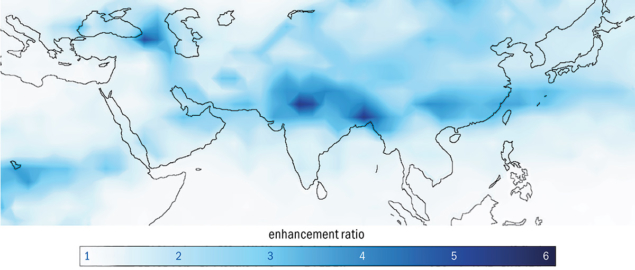
The CLOUD collaboration at CERN has uncovered a new mechanism accelerating the formation of aerosol particles in the upper troposphere, with potential implications for air-pollution regulations. The results, published in Nature on 18 May, show that an unexpected synergy between nitric acid, sulphuric acid and ammonia leads to the formation of aerosols at significantly faster rates than those from any two of the three components. The mechanism may represent a major source of cloud and ice seed particles in certain regions of the globe, says the team.
Aerosol particles are known to generally cool the climate by reflecting sunlight back into space and by seeding cloud droplets. But the vapours driving their formation are not well understood. The CLOUD (Cosmics Leaving Outdoor Droplets) facility at CERN’s East Area replicates the atmosphere in an ultraclean chamber to study, under precisely-controlled atmospheric conditions, the formation of aerosol particles from trace vapours and how they grow to become the seeds for clouds.
Three is key
Building on earlier findings that ammonia and nitric acid can accelerate the growth rates of newly formed particles, the CLOUD team introduced mixtures of sulphuric acid, nitric acid and ammonia vapours to the chamber and observed the rates at which particles formed. They found that the three vapours together form new particles 10–1000 times faster than a sulphuric acid–ammonia mixture, which previous CLOUD measurements suggested was the dominant source of upper tropospheric particles. Once the three-component particles form, they grow rapidly from the condensation of nitric acid and ammonia alone to sizes where they seed clouds.
Moreover, the team found these particles to be highly efficient at seeding ice crystals, comparable to desert dust particles, which are thought to be the most widespread and effective ice seeds in the atmosphere. When a supercooled cloud droplet freezes, the resulting ice particle will grow at the expense of any unfrozen droplets nearby, making ice a major factor in the microphysical properties of clouds and precipitation. Around three-quarters of global precipitation is estimated to originate from ice particles.
Feeding their measurements into global aerosol models that include vertical transport of ammonia by deep convective clouds, the CLOUD researchers found that although the particles form locally in ammonia-rich regions of the upper troposphere, such as over the Asian monsoon regions, they travel from Asia to North America in just three days via the subtropical jet stream, potentially influencing Earth’s climate on an intercontinental scale (see “Enhancement” figure). The importance of the new synergistic mechanism depends on the availability of ammonia in the upper troposphere, which originates mainly from livestock and fertiliser emissions. Atmospheric concentrations of all three compounds are much higher today than in the pre-industrial era.
“Our results will improve the reliability of global climate models in accounting for aerosol formation in the upper troposphere and in predicting how the climate will change in the future,” says CLOUD spokesperson Jasper Kirkby. “Once again, CLOUD is finding that anthropogenic ammonia has a major influence on atmospheric aerosol particles, and our studies are informing policies for future air-pollution regulations.”
Our results will improve the reliability of global climate models
Working at the intersection between atmospheric science and particle physics, CLOUD has published several important results since it started operations in 2009. These include new mechanisms responsible for driving winter smog episodes in cities and for potentially accelerating the loss of Arctic sea ice, in addition to studies of the impact of cosmic rays on clouds and climate (CERN Courier July/August 2020 p48).
“When CLOUD started operation, the prevailing understanding was that sulphuric acid vapour alone could account for almost all observations of new-particle formation in the atmosphere,” says Kirkby. “Our first experiments showed that it was around one million times too slow, and CLOUD went on to discover that additional vapours – especially biogenic vapours from trees – form particles together with stabilisers like ammonia, amines or ions from cosmic rays. CLOUD has now established a mechanistic understanding of aerosol particle formation for global climate models – but our work isn’t finished yet.”
Further reading
CLOUD Collaboration 2022 Nature 605 483.








